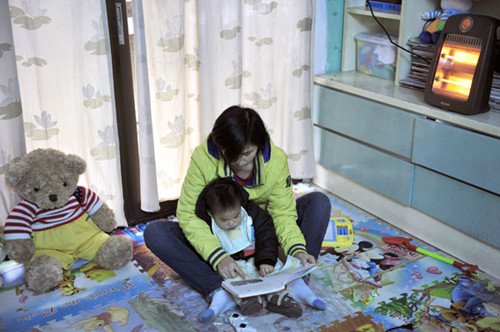
A mother reads a story to her child in front of an electric fi re in Fuzhou, Fujian province, on Friday. LIU TAO / FOR CHINA DAILY
On a typical night in December, Chen Lizhen sits in front of a TV in her apartment in Shanghai, fully dressed in a thick coat and sipping a cup of hot tea.
As the weather girl on TV cheerfully reminded her audience of another cold front already on the way from somewhere in the far north, the face of the 51-year-old former textile worker turned bleak.
"It means great discomfort in the coming week, and there is nowhere to escape (from the cold), even if you stay indoors," said Chen, glancing at the thermostat on the wall that registered a temperature of about 8 C.
"Sometimes I envy people living in the north because their rooms are very warm in winter because of their central heating system," said the woman, who, like hundreds of millions of residents in the south of China, has to rely on devices such as electric heaters to keep warm in winter.
Although the heavily subsidized central heating service provided to northern families may not be a universal solution to all living in the south, it is at least an option, she said.
The call to expand government-backed heating services to the south has never been as loud as this year, when the coldest winter in 28 years hit the country.
The mercury has been at an average of -3.8 C around China since November, or 1.3 degrees lower than the average for this period.
Along with the individuals who have been shivering through the cold and damp winter weather in their southern homes, People's Daily and Xinhua News Agency have urged regional authorities to take action, with the media outlets' calls being interpreted as a view that is supported by the central government.
The Ministry of Housing and Urban-Rural Development said on Wednesday that decentralized and regional heating systems are encouraged in areas that have sweltering summers but cold winters.
These areas involve regions in 14 provinces or municipalities in the south with a population of about 100 million, Xinhua quoted an unidentified ministry official as saying.
In these areas, residents are more uncomfortable than those living in the north when the mercury plummets below 5 C outdoors, and it is necessary to provide these regions with heating services, the ministry said.
The National Development and Reform Commission, China's top economic planner, said earlier this month that it has set up a research group to study the feasibility of a heating program in the south.
"It is the first time the issue was raised at the national level," said Lin Boqiang, head of the China Center for Energy Economics Research at Xiamen University.
A geographical line drawn in the 1950s to divide China into southern and northern parts has long been outdated and should be scrapped, he added.
But the question is: Where will the governments in the south find an energy source, and who will bear the costs of putting the heating facilities in place?
The Housing and Urban-Rural Development Ministry said electricity and renewable energy-powered heating should be promoted in the south, and the use of coal and a centralized heating system, both of which are in the north, should be discouraged.
The annual burning of 26 million metric tons of coal — which will happen if the south copies the traditional highly centralized heating system in the north — will discharge 73 tons of carbon dioxide, 52,000 tons of sulfur dioxide and 12,000 tons of dust into the atmosphere, according to the ministry.
But it did not specify if there will be any subsidies from governments to help develop costly renewable energies such as wind, hydropower, geothermal, solar and tidal.
Natural gas is another alternative and seems more practical in the south, but analysts said stronger demand from China may rattle international energy markets and push up prices of liquefied natural gas.
Most regional authorities said they have yet to research the subject, suggesting there will not be an immediate solution to the problem of heating in the south in the future.
Nanchang, capital of East China's Jiangxi province, is one of the handful of local governments to have encouraged heating powered by renewable energy.
But only an area of around 1 million square meters — a tiny share of its total area in the city with 5 million permanent residents — is heated by solar or geothermal energies.

Copyright ©1999-2011 Chinanews.com. All rights reserved.
Reproduction in whole or in part without permission is prohibited.